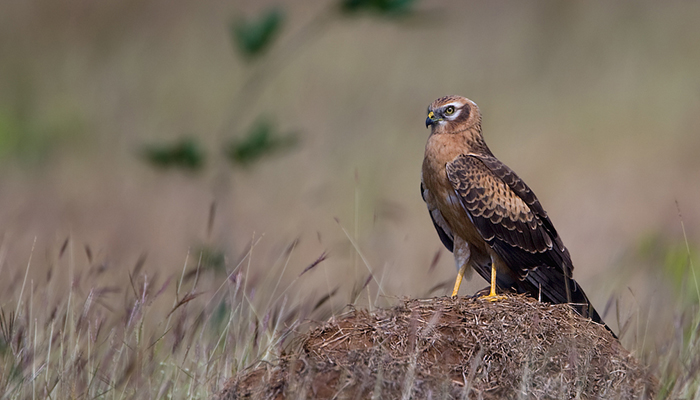
English: Montagu’s
Harrier
Russian: Луговой лунь
German: Wiesenweihe
French: Busard
cendre
Mongolian: Нугын хулд, Нугын цагаан элэгт
Japanese:
ヒメハイイロチュウヒ (Himehaiiro-chuhi)
Body Length: 39-50
cm
Wing span: 96-116 cm
Habitat: Summer
visitor, winters in Africa. Breeds on open plains, bogs, wasteland among arable
fields, heathland with low bushes. In Britain, sporadic breeder only, fewer
than 10 pairs. Food small birds or mammals, lizards, insects. Nests on ground.
Identification:
Very long and narrow wings (5th primary short, unlike on broader-winged Hen
Harrier), slim body and narrow, long tail. Flight buoyant and tern-like,
especially ♂. ♀ very similar to ♀ Pallid Harrier. Melanistic birds occur rarely
in W Europe.
- Adult
♂: Resembles ♂ Hen Harrier, but differs in shape, flight and in having black
bands across secondaries (two below, one above), more extensive black on
wing-tips, darker grey backlinner wing (upperparts appearing tricoloured, with
paler grey-white outer wing inside black tip). Chestnut streaks on belly
detectable at close range. (Very old ♂♂ have extensive blue-grey breast/upper
belly and lose much, occasionally all, of the chestnut streaking on belly).
- Adult
♀: Best separated from Hen Harrier by shape. From Pallid by slightly narrower
wing-base; obvious dark band across brown secondaries above, just outside
coverts; widely spaced prominent dark bands across pale buff secondaries below,
pale colour not darkening towards body as on Pallid; dark trailing edge on ‘hand’
below; and larger underwing-coverts and axillaries distinctly cross-barred.
- Juvenile:
Darker and more rufous than adult ♀, underparts uniformly chestnut or
golden-rufous, except for some dark streaks on side of breast on many (very
rare on Pallid). Secondaries dark, unbarred above and almost unbarred dark grey
below. Narrow pale band along greater coverts. Best distinguished from similar
juvenile Pallid by lack of prominent unstreaked buff-white neck-collar or
uniform dark brown sides of neck-there is no dark ‘boa’. ♂♂ have more irregular
barring below on primaries.
- 1st
summer ♂: Variable amount of dark grey feathers on head, neck and upper breast,
often creating (potentially misleading) effect of pale collar. Central
tail-feathers often moulted to greyish from April. Flight-feathers still
juvenile (brown, barred).